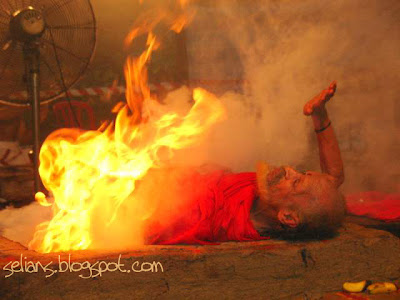Ganesha, ‘lingga yoni’ found at newly discovered site
Slamet Susanto , The Jakarta Post , Yogyakarta | Thu, 12/24/2009 9:26 AM | The Archipelago
Unearthed: An excavation team from the Yogyakarta Prehistoric Legacy Conservation Center examines a Ganesha statue and lingga yoni on Wednesday at the newly discovered site within the Indonesian Islamic University in Yogyakarta. The site was believed to be part of an ancient Hindu temple. JP/Tarko Sudiarno
The Yogyakarta Prehistoric Legacy Conservation Center (BP3) has found a Ganesha statue and lingga- yoni structures at the site of a newly discovered structure believed to be part of an ancient temple.
Head of the center’s protection working group Indung Panca Putra said the findings led the excavation team to conclude that the site, located in the Indonesian Islamic University (UII) campus on Jl. Kaliurang, Yogyakarta, was from a Hindu kingdom.
“We uncovered it Tuesday afternoon,” Indung said, adding that the team was forced to stop excavating shortly after due to fading light and decided to continue Wednesday.
The Ganesha was found facing west with an elevation of 17 degrees from the north. In Hindu mythology, Ganesha is the son of Shiva and is described as having a broken right tusk, a rope on his shoulders, a chain of pearls in his right hand and an axe in his left hand.
As of Wednesday the hands of the Ganesha were not unearthed as part of the body was still buried.
The lingga-yoni structures were found 85 centimeters to the east of the Ganesha.
The team expects to find two more statues on the site, because according to Hindu mythology lingga and yoni always accompany statues of Durga Mahisasura Mardini and Agastya.
“Materials from volcanic eruptions could have buried these two statues,” Indung said. The site is located at the base of Mount Merapi.
The excavation team, which began Saturday and will continue until January 4, have also uncovered 16 pieces of parts of a temple wall. “We will study the findings in order to decide how to proceed on this dig,” Indung said.
Compared to previous discoveries of Hindu temples in the region, this site is considered less elaborate. “The Ganesha, for example, is around 85 centimeters high while Prambanan Temple’s Ganesha is as tall as an adult,” Indung said.
The ornaments, he added, were also simpler. The head of the Ganesha found in Prambanan Temple, for example, has three levels with a crown on it. The one found at the site, however, has no crown and its hair is just tied.
These traits, according to Indung, show that the newly found temple served a smaller area. “If Prambanan Temple served an entire kingdom, for example, then this site would have served a village,” he said.
Indung, however, said his colleagues haven’t been able to estimate the age of the temple structure.
“This could be younger or older than Prambanan,” he said.
He added that based on the existing discovery, the site dated back to the ancient Mataram period between the 9th and 10th centuries. “We can ascertain the age of the site if we find the plaque identifying the year and the king who commissioned the temple,” Indung said.
The complex is closed to the public to secure the site. “If this proves to be an important site the owner will be compensated by BP3,” Indung said.
Construction workers accidentally found the temple structure last Friday while laying a foundation to build a library building at the university compound on Jl. Kaliurang in Umbulmartani subdistrict, Ngemplak district, Sleman regency.
UII Rector Edy Suandi Hamid confirmed his university will relocate the site of the library and is working with the BP3 and the Education Ministry.

Comments